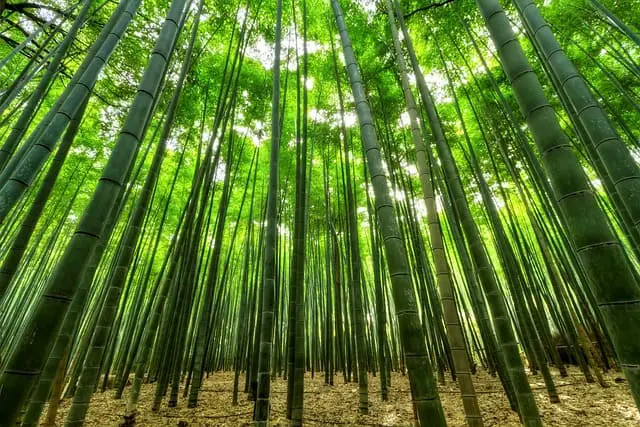Bamboo is a versatile grass that is widely known for its strength, durability, and fast growth rate. Over the years, it has been used for various purposes, including construction. The popularity of bamboo as a building material has risen in recent times due to the increasing concern for sustainability in construction.
Bamboo is often confused for a tree but as you’ll see below, it’s a plant that does have many of the same qualities as wood. This makes it an increasingly popular option for builders.
This article will explore the pros and cons of using bamboo as a sustainable building material.
Pros of Using Bamboo as a Building Material
- Renewable Resource: Bamboo is one of the fastest-growing plants in the world, with some species capable of growing up to 91 cm in just one day. This makes it a highly renewable resource, which makes it an attractive option for construction.
- Strong and Durable: Bamboo is a strong and durable material, again making it ideal for construction purposes. It has been found to be stronger than many types of wood, and its strength is comparable to that of steel. Bamboo’s janka rating tends to fall into the 3,000 – 4,000 range.
- Fast-growing: Bamboo grows much faster than traditional trees used for construction, such as oak or pine. This means that bamboo can be replenished much quicker than other types of wood, making it a sustainable option for construction.
- Environmentally Friendly: Bamboo is a highly environmentally friendly material, as it absorbs more carbon dioxide and produces more oxygen than most other plants. This makes it a great option for those looking to build in a sustainable and eco-friendly manner.
- Aesthetically pleasing: Bamboo is a beautiful material that can add a unique and attractive touch to any building. It is also a natural material that can help to create a sense of harmony with the environment.
Cons of Using Bamboo as a Building Material
- Availability: While bamboo is widely available in many countries, it is not always easy to find bamboo of the right quality and strength for construction purposes. This can limit its use as a building material in some areas.
- High Cost: Bamboo is often more expensive than traditional building materials, such as wood or concrete. This can make it a less attractive option for those on a budget.
- Maintenance and Preservation Requirements: Bamboo requires proper maintenance and preservation to ensure its longevity as a building material. This can include regular treatment with preservatives, proper storage and handling during construction, and proper installation techniques.
- Limited Uses: While bamboo is a versatile material, it is not suitable for all types of construction. For example, it is not recommended for use in areas with heavy rain or high humidity, as this can lead to rot and decay.
- Challenges in Constructing with Bamboo: Building with bamboo can also present some challenges, such as the need for specialized tools and techniques, and the need for skilled labor. This can make construction with bamboo more complex and time-consuming compared to using traditional building materials.

Comparison with Traditional Building Materials
Bamboo vs. Wood: Bamboo is often compared to traditional wood due to its strength and durability. However, bamboo is a more sustainable option, as it grows much faster than many traditional trees used for construction.
Bamboo vs. Concrete: While concrete is a strong and durable material, it has a much larger carbon footprint compared to bamboo. Bamboo is also a renewable resource, while concrete is a finite resource that is not easily replenished.
Bamboo vs. Steel: Steel is a strong and durable material, but it also has a large carbon footprint and is not a renewable resource. Bamboo is a more sustainable option due to its fast-growing nature and its much lower carbon footprint.
Case Studies and Real-Life Examples
Bamboo Houses: Bamboo houses can be found all over the world, from rural villages in developing countries to urban areas in developed countries such as Thailand and The Philippines. These houses are often designed and constructed to be both sustainable and aesthetically pleasing.
Bamboo Bridges: Bamboo bridges are a common sight in many parts of the world, particularly in rural areas in Thailand. These bridges are often used as a sustainable and cost-effective alternative to traditional bridges made of concrete or steel.
Bamboo Skyscrapers: Bamboo skyscrapers are a relatively new concept, but they are gaining popularity as a sustainable and eco-friendly alternative to traditional skyscrapers made of concrete and steel. These skyscrapers are often designed to incorporate bamboo into their structure, making them not only strong and durable, but also aesthetically pleasing. The first one was built in Singapore.
Summary
Bamboo is a versatile and sustainable building material with both positive attributes as well as important considerations. While it is a renewable resource that is strong and durable, it also has its challenges, such as limited availability and high cost.
Despite these challenges, bamboo has proven to be a successful building material in a variety of applications, from houses and bridges to skyscrapers. As more people become aware of the importance of sustainability in construction, it is likely that bamboo will continue to play a significant role in the future of sustainable building.


